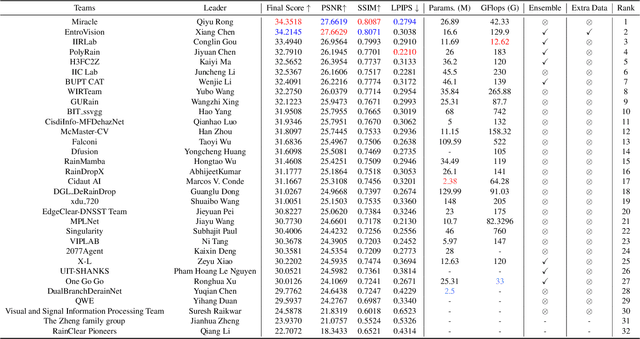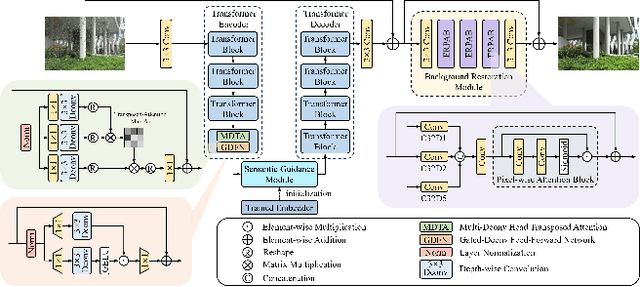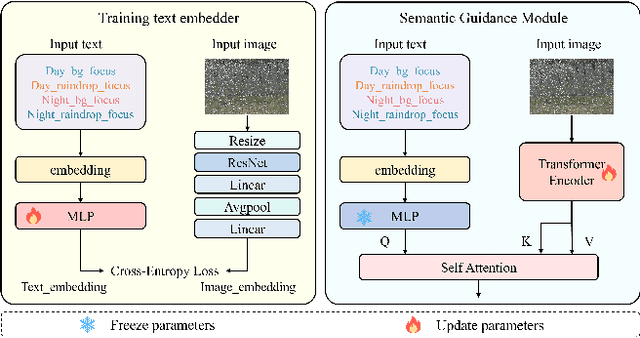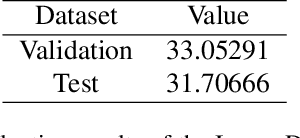Wenhan Yang
Privacy-Shielded Image Compression: Defending Against Exploitation from Vision-Language Pretrained Models
Jun 18, 2025Abstract:The improved semantic understanding of vision-language pretrained (VLP) models has made it increasingly difficult to protect publicly posted images from being exploited by search engines and other similar tools. In this context, this paper seeks to protect users' privacy by implementing defenses at the image compression stage to prevent exploitation. Specifically, we propose a flexible coding method, termed Privacy-Shielded Image Compression (PSIC), that can produce bitstreams with multiple decoding options. By default, the bitstream is decoded to preserve satisfactory perceptual quality while preventing interpretation by VLP models. Our method also retains the original image compression functionality. With a customizable input condition, the proposed scheme can reconstruct the image that preserves its full semantic information. A Conditional Latent Trigger Generation (CLTG) module is proposed to produce bias information based on customizable conditions to guide the decoding process into different reconstructed versions, and an Uncertainty-Aware Encryption-Oriented (UAEO) optimization function is designed to leverage the soft labels inferred from the target VLP model's uncertainty on the training data. This paper further incorporates an adaptive multi-objective optimization strategy to obtain improved encrypting performance and perceptual quality simultaneously within a unified training process. The proposed scheme is plug-and-play and can be seamlessly integrated into most existing Learned Image Compression (LIC) models. Extensive experiments across multiple downstream tasks have demonstrated the effectiveness of our design.
Structural Similarity-Inspired Unfolding for Lightweight Image Super-Resolution
Jun 13, 2025Abstract:Major efforts in data-driven image super-resolution (SR) primarily focus on expanding the receptive field of the model to better capture contextual information. However, these methods are typically implemented by stacking deeper networks or leveraging transformer-based attention mechanisms, which consequently increases model complexity. In contrast, model-driven methods based on the unfolding paradigm show promise in improving performance while effectively maintaining model compactness through sophisticated module design. Based on these insights, we propose a Structural Similarity-Inspired Unfolding (SSIU) method for efficient image SR. This method is designed through unfolding an SR optimization function constrained by structural similarity, aiming to combine the strengths of both data-driven and model-driven approaches. Our model operates progressively following the unfolding paradigm. Each iteration consists of multiple Mixed-Scale Gating Modules (MSGM) and an Efficient Sparse Attention Module (ESAM). The former implements comprehensive constraints on features, including a structural similarity constraint, while the latter aims to achieve sparse activation. In addition, we design a Mixture-of-Experts-based Feature Selector (MoE-FS) that fully utilizes multi-level feature information by combining features from different steps. Extensive experiments validate the efficacy and efficiency of our unfolding-inspired network. Our model outperforms current state-of-the-art models, boasting lower parameter counts and reduced memory consumption. Our code will be available at: https://github.com/eezkni/SSIU
Bootstrapping LLM Robustness for VLM Safety via Reducing the Pretraining Modality Gap
May 30, 2025Abstract:Ensuring Vision-Language Models (VLMs) generate safe outputs is crucial for their reliable deployment. However, LVLMs suffer from drastic safety degradation compared to their LLM backbone. Even blank or irrelevant images can trigger LVLMs to generate harmful responses to prompts that would otherwise be refused in text-only contexts. The modality gap between image and text representations has been recently hypothesized to contribute to safety degradation of LVLMs. However, if and how the amount of modality gap affects LVLMs' safety is not studied. In this work, we show that the amount of modality gap is highly inversely correlated with VLMs' safety. Then, we show that this modality gap is introduced during pretraining LVLMs and persists through fine-tuning. Inspired by this observation, we propose a regularization to reduce the modality gap during pretraining. Our extensive experiments on LLaVA v1.5, ShareGPT4V, and MiniGPT-4 show that our method substantially improves safety alignment of LVLMs, reducing unsafe rate by up to 16.3% without compromising performance, and can further boost existing defenses by up to 18.2%.
PRE-Mamba: A 4D State Space Model for Ultra-High-Frequent Event Camera Deraining
May 08, 2025Abstract:Event cameras excel in high temporal resolution and dynamic range but suffer from dense noise in rainy conditions. Existing event deraining methods face trade-offs between temporal precision, deraining effectiveness, and computational efficiency. In this paper, we propose PRE-Mamba, a novel point-based event camera deraining framework that fully exploits the spatiotemporal characteristics of raw event and rain. Our framework introduces a 4D event cloud representation that integrates dual temporal scales to preserve high temporal precision, a Spatio-Temporal Decoupling and Fusion module (STDF) that enhances deraining capability by enabling shallow decoupling and interaction of temporal and spatial information, and a Multi-Scale State Space Model (MS3M) that captures deeper rain dynamics across dual-temporal and multi-spatial scales with linear computational complexity. Enhanced by frequency-domain regularization, PRE-Mamba achieves superior performance (0.95 SR, 0.91 NR, and 0.4s/M events) with only 0.26M parameters on EventRain-27K, a comprehensive dataset with labeled synthetic and real-world sequences. Moreover, our method generalizes well across varying rain intensities, viewpoints, and even snowy conditions.
MTL-UE: Learning to Learn Nothing for Multi-Task Learning
May 08, 2025Abstract:Most existing unlearnable strategies focus on preventing unauthorized users from training single-task learning (STL) models with personal data. Nevertheless, the paradigm has recently shifted towards multi-task data and multi-task learning (MTL), targeting generalist and foundation models that can handle multiple tasks simultaneously. Despite their growing importance, MTL data and models have been largely neglected while pursuing unlearnable strategies. This paper presents MTL-UE, the first unified framework for generating unlearnable examples for multi-task data and MTL models. Instead of optimizing perturbations for each sample, we design a generator-based structure that introduces label priors and class-wise feature embeddings which leads to much better attacking performance. In addition, MTL-UE incorporates intra-task and inter-task embedding regularization to increase inter-class separation and suppress intra-class variance which enhances the attack robustness greatly. Furthermore, MTL-UE is versatile with good supports for dense prediction tasks in MTL. It is also plug-and-play allowing integrating existing surrogate-dependent unlearnable methods with little adaptation. Extensive experiments show that MTL-UE achieves superior attacking performance consistently across 4 MTL datasets, 3 base UE methods, 5 model backbones, and 5 MTL task-weighting strategies.
Open-set Anomaly Segmentation in Complex Scenarios
Apr 28, 2025Abstract:Precise segmentation of out-of-distribution (OoD) objects, herein referred to as anomalies, is crucial for the reliable deployment of semantic segmentation models in open-set, safety-critical applications, such as autonomous driving. Current anomalous segmentation benchmarks predominantly focus on favorable weather conditions, resulting in untrustworthy evaluations that overlook the risks posed by diverse meteorological conditions in open-set environments, such as low illumination, dense fog, and heavy rain. To bridge this gap, this paper introduces the ComsAmy, a challenging benchmark specifically designed for open-set anomaly segmentation in complex scenarios. ComsAmy encompasses a wide spectrum of adverse weather conditions, dynamic driving environments, and diverse anomaly types to comprehensively evaluate the model performance in realistic open-world scenarios. Our extensive evaluation of several state-of-the-art anomalous segmentation models reveals that existing methods demonstrate significant deficiencies in such challenging scenarios, highlighting their serious safety risks for real-world deployment. To solve that, we propose a novel energy-entropy learning (EEL) strategy that integrates the complementary information from energy and entropy to bolster the robustness of anomaly segmentation under complex open-world environments. Additionally, a diffusion-based anomalous training data synthesizer is proposed to generate diverse and high-quality anomalous images to enhance the existing copy-paste training data synthesizer. Extensive experimental results on both public and ComsAmy benchmarks demonstrate that our proposed diffusion-based synthesizer with energy and entropy learning (DiffEEL) serves as an effective and generalizable plug-and-play method to enhance existing models, yielding an average improvement of around 4.96% in $\rm{AUPRC}$ and 9.87% in $\rm{FPR}_{95}$.
Towards Model Resistant to Transferable Adversarial Examples via Trigger Activation
Apr 20, 2025Abstract:Adversarial examples, characterized by imperceptible perturbations, pose significant threats to deep neural networks by misleading their predictions. A critical aspect of these examples is their transferability, allowing them to deceive {unseen} models in black-box scenarios. Despite the widespread exploration of defense methods, including those on transferability, they show limitations: inefficient deployment, ineffective defense, and degraded performance on clean images. In this work, we introduce a novel training paradigm aimed at enhancing robustness against transferable adversarial examples (TAEs) in a more efficient and effective way. We propose a model that exhibits random guessing behavior when presented with clean data $\boldsymbol{x}$ as input, and generates accurate predictions when with triggered data $\boldsymbol{x}+\boldsymbol{\tau}$. Importantly, the trigger $\boldsymbol{\tau}$ remains constant for all data instances. We refer to these models as \textbf{models with trigger activation}. We are surprised to find that these models exhibit certain robustness against TAEs. Through the consideration of first-order gradients, we provide a theoretical analysis of this robustness. Moreover, through the joint optimization of the learnable trigger and the model, we achieve improved robustness to transferable attacks. Extensive experiments conducted across diverse datasets, evaluating a variety of attacking methods, underscore the effectiveness and superiority of our approach.
NTIRE 2025 Challenge on Day and Night Raindrop Removal for Dual-Focused Images: Methods and Results
Apr 19, 2025



Abstract:This paper reviews the NTIRE 2025 Challenge on Day and Night Raindrop Removal for Dual-Focused Images. This challenge received a wide range of impressive solutions, which are developed and evaluated using our collected real-world Raindrop Clarity dataset. Unlike existing deraining datasets, our Raindrop Clarity dataset is more diverse and challenging in degradation types and contents, which includes day raindrop-focused, day background-focused, night raindrop-focused, and night background-focused degradations. This dataset is divided into three subsets for competition: 14,139 images for training, 240 images for validation, and 731 images for testing. The primary objective of this challenge is to establish a new and powerful benchmark for the task of removing raindrops under varying lighting and focus conditions. There are a total of 361 participants in the competition, and 32 teams submitting valid solutions and fact sheets for the final testing phase. These submissions achieved state-of-the-art (SOTA) performance on the Raindrop Clarity dataset. The project can be found at https://lixinustc.github.io/CVPR-NTIRE2025-RainDrop-Competition.github.io/.
Towards Hierarchical Multi-Step Reward Models for Enhanced Reasoning in Large Language Models
Mar 19, 2025Abstract:Recent studies show that Large Language Models (LLMs) achieve strong reasoning capabilities through supervised fine-tuning or reinforcement learning. However, a key approach, the Process Reward Model (PRM), suffers from reward hacking, making it unreliable in identifying the best intermediate steps. In this paper, we propose a novel reward model approach, Hierarchical Reward Model (HRM), which evaluates both individual and consecutive reasoning steps from fine-grained and coarse-grained level. HRM performs better in assessing reasoning coherence and self-reflection, particularly when the previous reasoning step is incorrect. Furthermore, to address the inefficiency of autonomous generating PRM training data via Monte Carlo Tree Search (MCTS), we introduce a lightweight and effective data augmentation strategy called Hierarchical Node Compression (HNC) based on node merging (combining two consecutive reasoning steps into one step) in the tree structure. This approach diversifies MCTS results for HRM with negligible computational overhead, enhancing label robustness by introducing noise. Empirical results on the PRM800K dataset demonstrate that HRM, in conjunction with HNC, achieves superior stability and reliability in evaluation compared to PRM. Furthermore, cross-domain evaluations on MATH500 and GSM8K confirm HRM's superior generalization and robustness across diverse reasoning tasks. The code for all experiments will be released at https: //github.com/tengwang0318/hierarchial_reward_model.
Fast Omni-Directional Image Super-Resolution: Adapting the Implicit Image Function with Pixel and Semantic-Wise Spherical Geometric Priors
Feb 09, 2025



Abstract:In the context of Omni-Directional Image (ODI) Super-Resolution (SR), the unique challenge arises from the non-uniform oversampling characteristics caused by EquiRectangular Projection (ERP). Considerable efforts in designing complex spherical convolutions or polyhedron reprojection offer significant performance improvements but at the expense of cumbersome processing procedures and slower inference speeds. Under these circumstances, this paper proposes a new ODI-SR model characterized by its capacity to perform Fast and Arbitrary-scale ODI-SR processes, denoted as FAOR. The key innovation lies in adapting the implicit image function from the planar image domain to the ERP image domain by incorporating spherical geometric priors at both the latent representation and image reconstruction stages, in a low-overhead manner. Specifically, at the latent representation stage, we adopt a pair of pixel-wise and semantic-wise sphere-to-planar distortion maps to perform affine transformations on the latent representation, thereby incorporating it with spherical properties. Moreover, during the image reconstruction stage, we introduce a geodesic-based resampling strategy, aligning the implicit image function with spherical geometrics without introducing additional parameters. As a result, the proposed FAOR outperforms the state-of-the-art ODI-SR models with a much faster inference speed. Extensive experimental results and ablation studies have demonstrated the effectiveness of our design.
 Add to Chrome
Add to Chrome Add to Firefox
Add to Firefox Add to Edge
Add to Edge